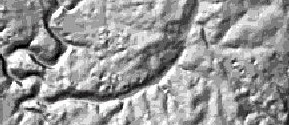


|
Sinkhole seen from the eastern side of the Camp Nelson National Cemetery. Little Hickman 7.5-minute Quadrangle. 26 KB image, 162 KB image. |

|
Large sinkhole seen from the northern side of the Camp Nelson National Cemetery. All of foreground is sloping toward the sinkhole. Little Hickman 7.5-minute Quadrangle. 28 KB image, 175 KB image. |